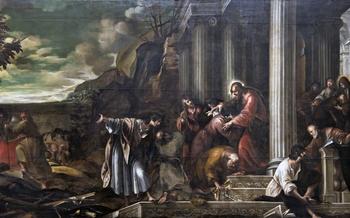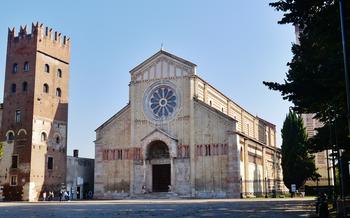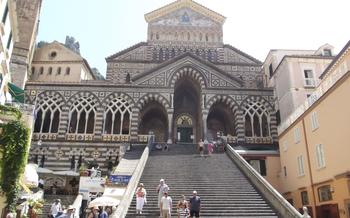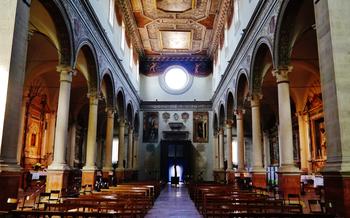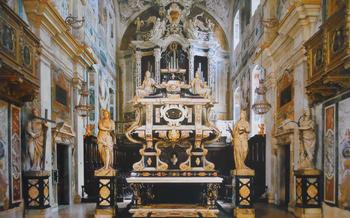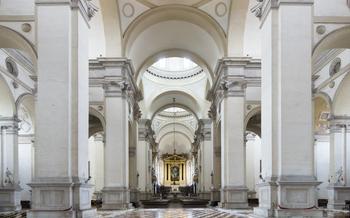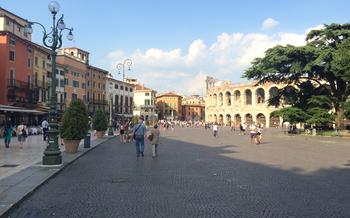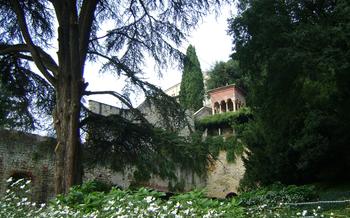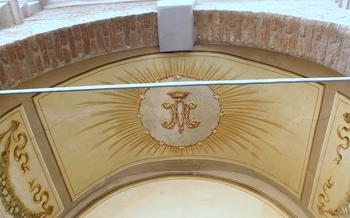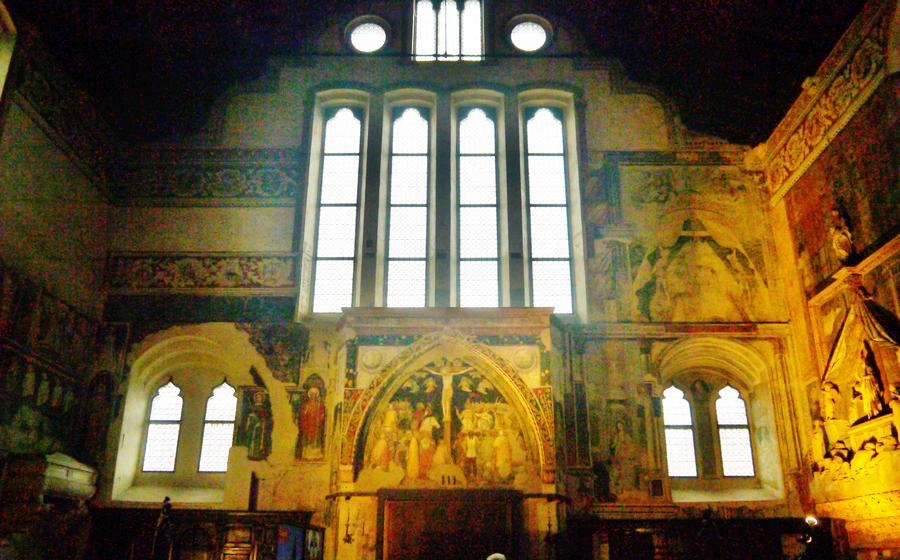
Chiesa di San Fermo Maggiore
- Introduction
- Location: A Hidden Gem in the Heart of Verona
- History
- Architecture
- Interior
- Altarpiece: A Masterpiece by Giovanni Francesco Caroto
- Bell Tower
- Piazza San Fermo
- Tombs and Sculptures
- The Organ
- Restoration
- Tips for Photography
- Insider's Tip: The Hidden Crypt
Introduction
Verona, the enchanting city in northeastern Italy, is renowned for its rich history, captivating culture, and architectural masterpieces that have earned it a place as a UNESCO World Heritage Site. Among these architectural treasures, the Chiesa di San Fermo Maggiore stands as a testament to the city's artistic and religious legacy. This remarkable church, with its blend of architectural styles and exquisite artistic elements, offers an immersive journey into the history and culture of Verona. In this comprehensive guide, we'll take you on a virtual tour of the Chiesa di San Fermo Maggiore, highlighting its captivating features and providing practical information for planning your visit.
Location: A Hidden Gem in the Heart of Verona
The Chiesa di San Fermo Maggiore stands as a testament to the rich history and artistic heritage of Verona, Italy. Situated in the heart of the city's historic center, the church can be found on Via San Fermo, a charming street lined with medieval buildings and bustling shops. Its strategic position, just a short walk from the renowned Piazza Bra and the lively Via Mazzini, makes it easily accessible on foot, allowing visitors to immerse themselves in the vibrant atmosphere of Verona's Old Town.
Whether you're exploring Verona by foot or relying on public transportation, reaching the Chiesa di San Fermo Maggiore is a breeze. Several bus lines stop within a short distance of the church, making it convenient for those who prefer to travel by bus. For those arriving by car, there are nearby parking options, including the Parcheggio Cittadella, which provides ample parking spaces for a hassle-free visit to this architectural masterpiece.
History
The Chiesa di San Fermo Maggiore, also known as the Church of Saint Fermo the Elder, is a treasure trove of history and religious significance. Its roots go back to the 11th century when a Benedictine monastery stood on the site. However, the church that stands today is a remarkable testament to the evolving architectural styles and artistic influences that have shaped Verona over the centuries.
Around the 13th century, the church underwent a major transformation, and its Romanesque structure was expanded and enhanced with Gothic elements. These additions, including pointed arches, ribbed vaults, and intricate tracery, infused the church with a sense of lightness and elegance that was characteristic of the Gothic period.
During the Renaissance, the church saw further embellishments and renovations. The graceful Renaissance influence can be seen in the addition of the side chapels, the elegant cloister, and the stunning altarpiece by Giovanni Francesco Caroto. This altarpiece, a masterpiece of the Renaissance era, is a testament to the artistic prowess that flourished in Verona during this period.
Throughout the centuries, the Chiesa di San Fermo Maggiore has undergone various renovations and restorations, each contributing to its rich history and ensuring its preservation for generations to come.
Architecture
The Chiesa di San Fermo Maggiore is a captivating blend of architectural styles, showcasing the evolution of artistic influences in Verona. Its facade, boasting a Romanesque design, features intricate arches and delicate bas-reliefs, setting the stage for the awe-inspiring interiors. Upon entering the church, visitors are greeted by Gothic elements, such as the pointed arches and ribbed vaulting, which contribute to an atmosphere of grandeur and elegance. The Renaissance era also left its mark on San Fermo Maggiore, evident in the refined carvings and decorative details found throughout the church. The harmonious fusion of these architectural styles creates a unique and awe-inspiring atmosphere that transports visitors back in time.
Interior
The interior of the Chiesa di San Fermo Maggiore is equally captivating, boasting a harmonious blend of architectural styles and artistic expressions. As you step inside, you'll be awestruck by the church's spacious layout, which allows for the graceful flow of light and movement. The walls and ceilings are adorned with remarkable frescoes, each telling a biblical story or depicting a scene from the life of a saint. Their vibrant colors and intricate details bring the biblical narratives to life, immersing visitors in a realm of divine art.
Beyond the frescoes, the church is embellished with intricate carvings, sculptures, and other artistic elements that showcase the skill and artistry of the craftsmen who worked on its construction. Every corner, every alcove, and every arch reveals a hidden treasure, whether it's a delicate bas-relief, an expressive statue, or an elegant stained-glass window. The harmonious interplay of these artistic elements creates a sense of awe and wonder, leaving visitors with a lasting impression of the church's spiritual and aesthetic beauty.
Altarpiece: A Masterpiece by Giovanni Francesco Caroto
Among the many artistic treasures housed within the Chiesa di San Fermo Maggiore, the altarpiece by Giovanni Francesco Caroto stands out as a true masterpiece. Crafted in the early 16th century, this remarkable work of art is a testament to Caroto's exceptional skill and devotion to his craft.
The altarpiece depicts a series of biblical scenes with intricate detail and vibrant colors, capturing the essence of the sacred narratives they portray. The central panel features the Madonna and Child enthroned, surrounded by a celestial host of angels and saints. The surrounding panels depict various episodes from the life of Jesus, including his birth, crucifixion, and resurrection.
Caroto's use of perspective, lighting, and symbolism is masterful, creating a sense of depth and drama that draws the viewer into the sacred stories. The altarpiece is a testament to the artist's deep understanding of the Bible and his ability to translate its messages into a visually stunning work of art.
This breathtaking altarpiece is a must-see for any visitor to the Chiesa di San Fermo Maggiore. It is a true masterpiece that showcases the artistic genius of Giovanni Francesco Caroto and serves as a reminder of the enduring power of religious art.
Bell Tower
The bell tower of the Chiesa di San Fermo Maggiore stands tall and proud, reaching towards the heavens. Its slender, octagonal structure is a testament to the architectural prowess of its builders. The tower's exterior is adorned with intricate carvings and delicate tracery, showcasing the attention to detail that went into its construction.
The tower's height offers breathtaking views of Verona, with the red-tiled roofs of the city stretching out in all directions. Visitors can climb the tower's narrow staircase to reach the viewing platform, where they are rewarded with panoramic vistas that encompass iconic landmarks such as the Arena di Verona and the Torre dei Lamberti.
Legends and stories surround the bell tower of the Chiesa di San Fermo Maggiore. One tale speaks of a young bell ringer who, during a raging storm, bravely climbed the tower to ring the bells and warn the city of an impending flood. His actions saved countless lives, and to this day, the sound of the bells is said to carry a special resonance, echoing the memory of his heroic deed.
The bell tower not only serves as a symbol of the church's enduring presence but also stands as a reminder of the rich history and enduring spirit of the city of Verona. Its timeless beauty and enduring stories continue to captivate visitors and locals alike, making it an essential stop on any journey through this enchanting city.
Piazza San Fermo
In front of the Chiesa di San Fermo Maggiore lies the enchanting Piazza San Fermo, a vibrant square that brims with activity and charm. Surrounded by medieval buildings with pastel-hued facades, the piazza exudes an atmosphere that transports visitors back in time. It serves as a meeting point for locals and tourists alike, who gather to savor a cup of espresso at one of the many cafés or browse the shops selling local crafts and souvenirs. Whether it's enjoying a leisurely lunch on a sun-drenched terrace or simply soaking in the lively ambiance, Piazza San Fermo offers a delightful experience for all.
Tombs and Sculptures
Within the hallowed walls of the Chiesa di San Fermo Maggiore, visitors can admire an array of impressive tombs and sculptures that stand as testaments to the church's rich history and artistic heritage. Among the most notable is the tomb of Cangrande della Scala, the illustrious lord of Verona who ruled during the 14th century. Crafted from exquisite white marble, the tomb features an intricate canopy adorned with delicate carvings and sculptures depicting scenes from Cangrande's life.
Another remarkable sculptural masterpiece is the monument to the Pellegrini family, created by the renowned Renaissance sculptor Michele Sanmicheli. This elaborate tomb boasts a stunning combination of marble and bronze, showcasing the artist's virtuosity in depicting lifelike figures and intricate details. The Pellegrini monument serves as a poignant reminder of the enduring legacy of this prominent Veronese family.
As you explore the church, don't miss the captivating sculptural works by Jacopo Bellini, the father of the legendary Renaissance painter Giovanni Bellini. His delicate reliefs grace the choir stalls, narrating biblical stories with exquisite precision. These works not only demonstrate Bellini's mastery of the craft but also offer a glimpse into the artistic influences that shaped the early Renaissance.
The Organ
The Chiesa di San Fermo Maggiore is also home to a magnificent organ, a testament to the church's rich musical heritage. Constructed by the renowned organ builder Gaetano Callido in 1851, this masterpiece of craftsmanship boasts over 2,000 pipes, each meticulously handcrafted and tuned to perfection. The organ's intricate facade, adorned with delicate carvings and gilded embellishments, complements the grandeur of the church's interior.
When played by skilled organists, the Callido organ fills the sacred space with enchanting melodies that resonate through the centuries. Its versatility allows for the performance of both sacred and secular music, from soaring Bach fugues to serene Renaissance compositions. Whether accompanying liturgical services or showcasing the talents of visiting musicians, the organ's enchanting sounds transport listeners to a realm of spiritual and aesthetic transcendence.
Restoration
The Chiesa di San Fermo Maggiore has undergone several restoration projects throughout the centuries to preserve its architectural integrity and artistic treasures. One of the most significant renovations occurred in the late 19th century, when the church's facade was restored to its original Romanesque appearance. During this time, the church's interior was also refurbished, with the addition of new frescoes and the restoration of existing artwork.
More recently, in the early 21st century, another extensive restoration project was undertaken to address structural issues and further enhance the church's beauty. This project involved reinforcing the foundations, repairing the roof, and cleaning and conserving the church's interior surfaces. As a result of these restoration efforts, the Chiesa di San Fermo Maggiore stands today as a testament to the enduring craftsmanship and artistic heritage of Verona.
Tips for Photography
With its blend of architectural styles and exquisite artworks, the Chiesa di San Fermo Maggiore is a treasure trove for photographers. To capture the church's grandeur, arrive early or late in the day, when the sunlight casts a warm glow on its facade. Utilize a wide-angle lens to encompass the entire structure, including the bell tower and the Piazza San Fermo. Don't miss the intricate details of the Romanesque portal and the Gothic windows, and take the time to photograph the frescoes and sculptures inside the church. For a unique perspective, head to the Piazza delle Erbe and capture the church's silhouette against the backdrop of the surrounding buildings. Remember to be respectful of the church's sacred nature, and avoid using flash photography or disturbing worshippers.
Insider's Tip: The Hidden Crypt
Venture beyond the main sanctuary of the Chiesa di San Fermo Maggiore to discover a hidden gem—the crypt beneath the church. This subterranean chamber holds a collection of ancient artifacts, including relics of early Christian martyrs and fragments of Romanesque frescoes. While rarely open to the public, the crypt occasionally offers guided tours that provide a glimpse into the church's rich past and the lives of its faithful. Be sure to inquire about these tours and seize the opportunity to delve deeper into the spiritual history of Verona.
